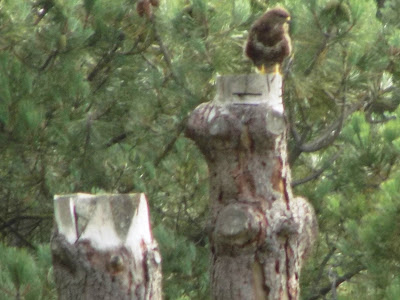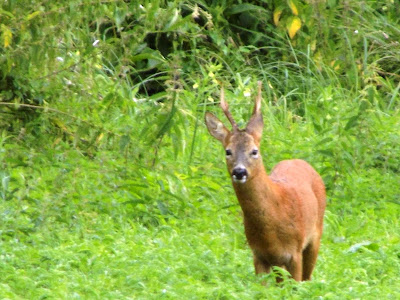Let's start with some birds. I was delighted to spot some swallow chicks calling for food on reeds on the shore of the Avon recently.
Given the time of year it's possible that these chicks are from a second brood- swallows tend to have two broods a year. The young stay with their parents for about a week after leaving the nest which means these chicks hatched around a month ago. Sometimes birds from the first brood will assist in feeding birds from the second brood- these young chicks may have been fed by their older siblings as well as their parents.
I spotted on our local buzzards recently.
A few weeks ago I talked about how buzzards like to perch on dead trees where there are no leaves to obscure their view. This guy was having none of it and sat happily amongst the leaves!
Before sitting on the tree this individual spent a long time circling the skies on the thermals. I've tried to capture buzzards in the air many times but it really works- this time I at least got a passable photo.
On the path near the buzzard I saw loads of these forest bugs sat on top of the fence posts.
I've seen several similar shield bugs over the summer but this species is the largest and has a dash of colour to it as well. This bug mainly feeds on the sap of oak trees but will also feed on other trees and will even eat caterpillars and insects.
Which is bad news for this fellow who I found crawling down another of the fence posts. It turned out this one was easier to video than photograph.
I'm not sure on the species of this- it's likely to be a geometrid, i.e. a member of the geometer moth family but it's too difficult to tell beyond that. I love the way taps the tiny fly as it crawls along here.
It wasn't the only caterpillar I spotted recently as I saw this magnificent specimen sat on a bench:
This is a buff-tip moth caterpillar. The moth itself looks really like a bit of branch but the caterpillar is much more visible. The caterpillars feed on a range of deciduous trees and can even defoliate entire branches. They overwinter as pupae in the ground.
I've also seen a few adult moths lately. This is not a great photo but thanks to the distinguishing feature it's clearly a silver Y moth.
You can see a silver letter 'y' on the wing of this moth, making it perhaps the easiest moth to identify from this angle. Whilst virtually all the moths I have been able to identify were seen during the day, I did spot this one attracted to the light of our conservatory one evening.
This is the dusky pearl moth (Udea prunalis). As you'd expect this is a nocturnal species and one that is only seen over the summer months, between June and August. It likes hedgerows so is probably attracted to the overgrown hedge in next door's garden.
A few fungi to finish I think. First here is an Amnita though I'm not sure of the exact species.
What I am sure of is that this would make you very ill if you tried to eat it. Next we have the Blackening Waxcap (Hygrocybe conica).
This species turns black with age, hence the name. There's debate on how edible this one is- some say you can eat but there have been at least one report of poisoning from eating this species in the past. Suffice to say I won't be trying it anytime soon.
Finally, here's a scarlet brittlegill (or potentially a similar species).
Again there are reports this is edible but eating something that is bright red is never a sensible idea. There's a reasons why the russulaceae are sometimes also known as 'sickeners'!




















































